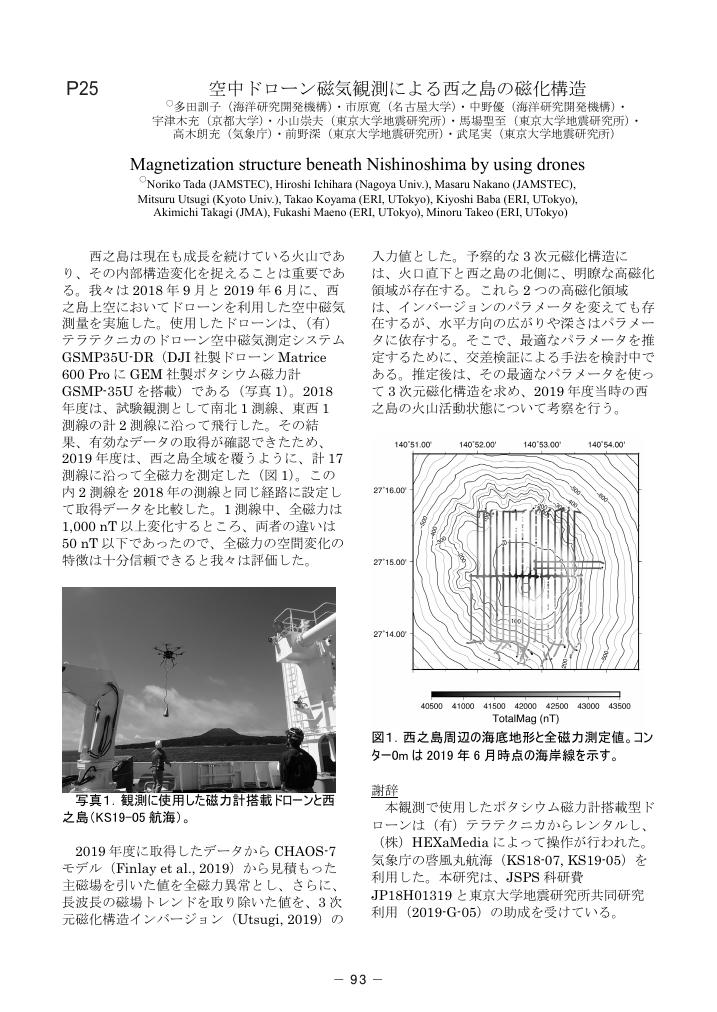3 0 0 0 OA 西之島の地球物理観測と上陸調査
- 著者
- 武尾 実 大湊 隆雄 前野 深 篠原 雅尚 馬場 聖至 渡邉 篤志 市原 美恵 西田 究 金子 隆之 安田 敦 杉岡 裕子 浜野 洋三 多田 訓子 中野 俊 吉本 充宏 高木 朗充 長岡 優
- 出版者
- 海洋理工学会
- 雑誌
- 海洋理工学会誌 (ISSN:13412752)
- 巻号頁・発行日
- vol.24, no.1, pp.45-56, 2018 (Released:2018-08-30)
- 参考文献数
- 12
Nishinoshima is an andesitic stratovolcano located in Ogasawara Islands, Japan. In November 2013, island-forming eruption started. Before the eruption, Nishinoshima was a small island of the area of 0.29 km2 and elevation of 25 m but it had a huge edifice rising 3,000 m from the sea floor. By March 2016, area and elevation reached 2.7 km2 and 140 m, respectively. We conducted various types of geophysical observations at this “difficult-to-access island” (950 km from Tokyo taking 90 min by Jet plane, or 24 h by ship). In June 2016, we conducted airborne observations using unmanned helicopter, collecting 250 grams of scoria and detailed 4K images of lava flows. OBSs (Ocean Bottom Seismometers) were deployed around Nishinoshima in four periods. From February 2015 to May 2017, characteristic waveforms dominated at 4–8 Hz band were frequently observed. Comparisons with infrasonic records and video images revealed that the 4–8 Hz seismic signals were associated with eruptions at pyroclastic cone. The number of seismic signals of this type declined from July 2015, and disappeared in November 2015, suggesting that the eruptive activity started declining in July 2015 and ceased in the middle of November 2015. In October 2016, we landed and deployed a broadband seismometer and an infrasonic sensor in the old Nishinoshima, collecting a lot of new lava, deposits, and ash samples. We demonstrated a capacity of remote-island volcano monitoring system for one day test navigation circling around Nishinoshima. After one and a half year quiescence, a new eruptive phase started in April, 2017. Our on-land seismic sensor detected precursory signals as early as April 17. The seismometer also recorded characteristic waveforms during the very early stage of the new eruption phase before data transmission was terminated on April 21.
2 0 0 0 OA 無人ヘリによる西之島の観測 (1): 試料採取と4K画像の撮影
- 著者
- 金子 隆之 大湊 隆雄 武尾 実 小山 崇夫 前野 深 安田 敦 中田 節也 渡邉 篤志 高木 朗充 長岡 優
- 出版者
- 特定非営利活動法人 日本火山学会
- 雑誌
- 日本火山学会講演予稿集 2016 (ISSN:24335320)
- 巻号頁・発行日
- pp.125, 2016 (Released:2017-02-07)
1 0 0 0 OA 空中ドローン磁気観測による西之島の磁化構造
- 著者
- 多田 訓子 市原 寛 中野 優 宇津木 充 小山 崇夫 馬場 聖至 高木 朗充 前野 深 武尾 実
- 出版者
- 特定非営利活動法人 日本火山学会
- 雑誌
- 日本火山学会講演予稿集 2020 (ISSN:24335320)
- 巻号頁・発行日
- pp.93, 2020 (Released:2021-02-01)
1 0 0 0 OA B12 硫黄鳥島火山の地震活動
- 著者
- 高木 朗充 高山 博之 前田 憲二 中村 雅基 黒木 英州 ト部 卓
- 出版者
- 特定非営利活動法人 日本火山学会
- 雑誌
- 日本火山学会講演予稿集 2004 (ISSN:24335320)
- 巻号頁・発行日
- pp.76, 2004-10-19 (Released:2017-02-10)
1 0 0 0 OA 霧島火山群における人工地震探査 : 観測および初動の読みとり
- 著者
- 鍵山 恒臣 筒井 智樹 三ヶ田 均 森田 裕一 松島 健 井口 正人 及川 純 山岡 耕春 熊谷 博之 西村 裕一 宮町 宏樹 渡辺 了 西村 太志 高木 朗充 山本 圭吾 浜口 博之 岡田 弘 前川 徳光 大島 弘光 植木 貞人 橋本 恵一 仁田 交一 茂原 諭 中道 治久 汐見 勝彦 中原 恒 青木 重樹 青地 秀雄 井田 喜明
- 出版者
- 東京大学地震研究所
- 雑誌
- 東京大学地震研究所彙報 (ISSN:00408972)
- 巻号頁・発行日
- vol.70, no.2/4, pp.33-60, 1996-03-15
In recent years, investigations on the structures of volcanoes have been noteworthy for further understanding volcanic processes, including locations of magma reservoirs, magma rising process before eruptions and causes of related phenomena. In 1994, a joint experiment was conducted on Kirishima Volcanoes, Southern Kyushu, to reveal the structure and the magma supply system by a group of scientists from national universities under the National Research Project for the Prediction of Volcanic Eruptions. The experiment was carried out by seismological, electromagnetic and other geophysical methods. The following seven papers including this one present some results of the experiments. This paper outlines a seismic explosion experiment in Kirishima, and presents all data on the first motion. An extensive explosion seismic experiment was conducted on December 1, 1994. Observations were made along a 30-km major line lying in the NNW-SSE direction and other sub-lines which cross the major line in and around the Kirishima Volcanoes. Along these lines, 6 shots with a charge size of 200-250 kg, and 163 temporary observations were arranged by many universities and institutes. A newly developed data logger was used for these temporal observations, and the position of each site was determined by GPS. All 6 shots were successfully fired, and clear onset and significant phases were observed at most observation sites. A travel time diagram suggests that a high velocity layer crops out south of the Kirishima Volcanoes, while in the Kirishima Volcanoes, this layer is covered with a lower velocity layer, which is thick at the northern part. It is also suggested that a structural discontinuity exists between S3 and S4.


